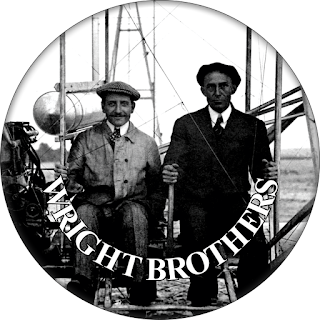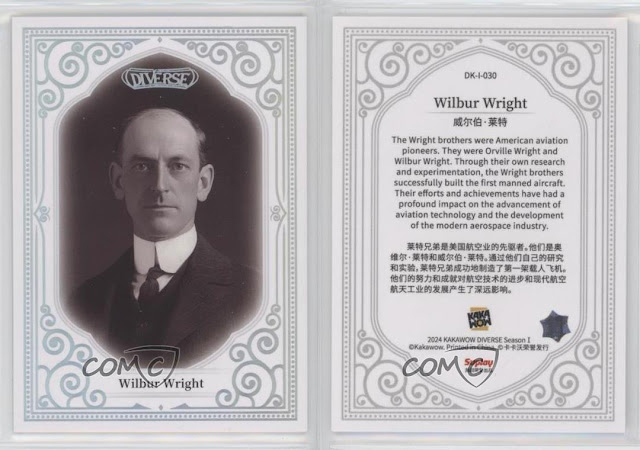Bonebreak and Higgenbottom- As told by Ivonette Wright Miller in Wright Reminiscences.(Lorin Wright's children were Milton, Horace, Ivonette, and Leontine).
"On some of our evening visits, there would be a magic lantern show, or perhaps a shadowgraph show. There were two characters that took part in the shadowgraph shows, Sam Bonebrake, who was tall and thin, and Jim Higgenbottom, who was short and fat and had a high squeaky voice. There was always a big build-up before each show. Uncle Orv and Uncle Will spent hours in the shop making these jointed sheet metal figures."
Christmas Eve Prank- As told by Ivonette Wright Miller in Wright Reminiscences.
"The first Christmas after we were married, we went out to Hawthorn Hill for Christmas Eve, as the family had done for years. When we sat down at the table, we all picked up our place cards, which were envelopes bearing each one's name. Each contained a new twenty dollar bill. At Scribze's place was a box of candy. He thanked Orv for it and nothing more was said for awhile. Then someone spoke up and said to Scribze, 'I'll bet there's a bill in yours somewhere, why don't you look and see?' Scribze said he was satisfied but because we all insisted, he opened the box of candy and went all through it- no money. He was becoming more and more embarrassed by the minute. Uncle Orv was chuckling all through this procedure, but said nothing. Finally someone said 'why don't you take the box apart? I'm sure it's in there somewhere'. That he did, and slipped in under the covering of the box was his twenty dollar bill. Uncle Orv had carefully taken the whole cover off and pasted it back together again. He enjoyed every minute of this prank."
Thanksgiving Day Prank- As told by Ivonette Wright Miller in Wright Reminiscences.
"It was our custom to have dinner at Hawthorn Hill both Thanksgiving and Christmas Eve for the whole family. This was carried on until Orville's death. At one Thanksgiving dinner, as a prank, he had Carrie his housekeeper, prepare the turkey in a special way. Nearly all the family preferred dark meat, and at this time- we were surprised that as Uncle Orv carved- the supply never gave out. One of us remarked 'This is good turkey, but you know, it tastes like duck to me.' With that Uncle Orv went into a fit of laughter. He turned the platter around to show that the turkey was only a front. Most of the dark meat was duck."
Wedding gift Prank- As told by Leontine Wright Jameson in Wright Reminiscences.
"Our wedding, John's and mine, took place in the big home that the family had built and moved into in Oakwood, Hawthorn Hill. It was necessary to do some rehearsing for the big event and we were invited to come to Hawthorn Hill for dinner and rehearsal. Before dinner Uncle Orville called me and John aside and presented us a toy pirate's chest. It was quite heavy and we were mystified. When we opened up the chest to see what it contained, we found it full of large nails. I remarked that these would be good to use whenever we could build our first home. Uncle Orville thoroughly enjoyed watching our reactions and laughed in great glee. Soon, however, he exchanged the nail-filled chest for a similar one and we weren't sure what to expect. This one contained gold coins and, of course, we were pleased and surprised. The first and second toy chests looked and weighed the same and I'm sure Uncle Orville had spent quite a bit of time making them the same, so as to make his practical joke more plausible and more fun for all interested."
Valentines Day Prank- As told by Horace (Bus) Wright in Wright Reminiscences.
"As a small boy we used to make a lot of Valentine Day. After dark we would put down valentines at the door, stamp our feet and run. One year Uncle Orv put on a yellow raincoat, a top hat and when he heard the kids coming down the street, slid out the back door and around the corner so he would be following us as we approached his house. I had slipped in the gate and was going up on the porch, Uncle Orv turned in the gate, caught me under his arm and carried me into the house. As they all sat around laughing, I slipped out and down the street to a light. In my collection of comic valentines (as they were known then) I found one of a pig in a top hat and coat very similar to that Uncle Orv had used. It had a verse on it something about his pigish ways and I left it while they were still laughing on the inside."
Mashed Potatoes Prank- As told by Horace (Bus) Wright in Wright Reminiscences.
"During many of our Sunday dinners they used to tease me as to whether they had enough potatoes, since I always liked mashed potatoes. One Sunday Uncle Orv remarked 'It seems funny how Bus's plate always makes for the mashed potatoes' and with that my plate started to move towards the mashed potatoes he was serving. It turned out he had pasted a thread to the bottom of my plate which he had pulled toward him."
"On some of our evening visits, there would be a magic lantern show, or perhaps a shadowgraph show. There were two characters that took part in the shadowgraph shows, Sam Bonebrake, who was tall and thin, and Jim Higgenbottom, who was short and fat and had a high squeaky voice. There was always a big build-up before each show. Uncle Orv and Uncle Will spent hours in the shop making these jointed sheet metal figures."
Christmas Eve Prank- As told by Ivonette Wright Miller in Wright Reminiscences.
"The first Christmas after we were married, we went out to Hawthorn Hill for Christmas Eve, as the family had done for years. When we sat down at the table, we all picked up our place cards, which were envelopes bearing each one's name. Each contained a new twenty dollar bill. At Scribze's place was a box of candy. He thanked Orv for it and nothing more was said for awhile. Then someone spoke up and said to Scribze, 'I'll bet there's a bill in yours somewhere, why don't you look and see?' Scribze said he was satisfied but because we all insisted, he opened the box of candy and went all through it- no money. He was becoming more and more embarrassed by the minute. Uncle Orv was chuckling all through this procedure, but said nothing. Finally someone said 'why don't you take the box apart? I'm sure it's in there somewhere'. That he did, and slipped in under the covering of the box was his twenty dollar bill. Uncle Orv had carefully taken the whole cover off and pasted it back together again. He enjoyed every minute of this prank."
Thanksgiving Day Prank- As told by Ivonette Wright Miller in Wright Reminiscences.
"It was our custom to have dinner at Hawthorn Hill both Thanksgiving and Christmas Eve for the whole family. This was carried on until Orville's death. At one Thanksgiving dinner, as a prank, he had Carrie his housekeeper, prepare the turkey in a special way. Nearly all the family preferred dark meat, and at this time- we were surprised that as Uncle Orv carved- the supply never gave out. One of us remarked 'This is good turkey, but you know, it tastes like duck to me.' With that Uncle Orv went into a fit of laughter. He turned the platter around to show that the turkey was only a front. Most of the dark meat was duck."
Wedding gift Prank- As told by Leontine Wright Jameson in Wright Reminiscences.
"Our wedding, John's and mine, took place in the big home that the family had built and moved into in Oakwood, Hawthorn Hill. It was necessary to do some rehearsing for the big event and we were invited to come to Hawthorn Hill for dinner and rehearsal. Before dinner Uncle Orville called me and John aside and presented us a toy pirate's chest. It was quite heavy and we were mystified. When we opened up the chest to see what it contained, we found it full of large nails. I remarked that these would be good to use whenever we could build our first home. Uncle Orville thoroughly enjoyed watching our reactions and laughed in great glee. Soon, however, he exchanged the nail-filled chest for a similar one and we weren't sure what to expect. This one contained gold coins and, of course, we were pleased and surprised. The first and second toy chests looked and weighed the same and I'm sure Uncle Orville had spent quite a bit of time making them the same, so as to make his practical joke more plausible and more fun for all interested."
Valentines Day Prank- As told by Horace (Bus) Wright in Wright Reminiscences.
"As a small boy we used to make a lot of Valentine Day. After dark we would put down valentines at the door, stamp our feet and run. One year Uncle Orv put on a yellow raincoat, a top hat and when he heard the kids coming down the street, slid out the back door and around the corner so he would be following us as we approached his house. I had slipped in the gate and was going up on the porch, Uncle Orv turned in the gate, caught me under his arm and carried me into the house. As they all sat around laughing, I slipped out and down the street to a light. In my collection of comic valentines (as they were known then) I found one of a pig in a top hat and coat very similar to that Uncle Orv had used. It had a verse on it something about his pigish ways and I left it while they were still laughing on the inside."
Mashed Potatoes Prank- As told by Horace (Bus) Wright in Wright Reminiscences.
"During many of our Sunday dinners they used to tease me as to whether they had enough potatoes, since I always liked mashed potatoes. One Sunday Uncle Orv remarked 'It seems funny how Bus's plate always makes for the mashed potatoes' and with that my plate started to move towards the mashed potatoes he was serving. It turned out he had pasted a thread to the bottom of my plate which he had pulled toward him."
Orville Wright is really enjoying himself in this 1941 photo of himself with Lt. General William Knudsen inspecting a plane motor. Here is what I imagine William said to Orville just as the photographer took the picture-
 | ||||||
| Hey Orville, I'll bet that first flight in '03 would have gone farther than 120 feet, if you had had this puppy on board!
Copyright 2021-Getting the Story Wright
For more Wright Brother humor, go to "Connecticut, you have Gustave be kidding me!"
For alternate Wright Brother timeline humor, go to "What if the Wright Brothers had not experimented in flight in the early 1900's?" For more alternate timeline humor, go to "An Alternate Time line- The 1905 Wright Flyer III flies again" Index of Topics |























